[English] 日本語
 Yorodumi
Yorodumi- PDB-2ha1: Complex of the first and second type III domains of human Fibrone... -
+ Open data
Open data
- Basic information
Basic information
| Entry | Database: PDB / ID: 2ha1 | ||||||
|---|---|---|---|---|---|---|---|
| Title | Complex of the first and second type III domains of human Fibronectin in solution | ||||||
 Components Components | Fibronectin | ||||||
 Keywords Keywords | CELL ADHESION / STRUCTURAL PROTEIN / Beta sandwich / Protein-Protein complex / Rigid body docking | ||||||
| Function / homology |  Function and homology information Function and homology informationnegative regulation of monocyte activation / negative regulation of transforming growth factor beta production / Extracellular matrix organization / positive regulation of substrate-dependent cell migration, cell attachment to substrate / calcium-independent cell-matrix adhesion / Fibronectin matrix formation / neural crest cell migration involved in autonomic nervous system development / fibrinogen complex / peptide cross-linking / integrin activation ...negative regulation of monocyte activation / negative regulation of transforming growth factor beta production / Extracellular matrix organization / positive regulation of substrate-dependent cell migration, cell attachment to substrate / calcium-independent cell-matrix adhesion / Fibronectin matrix formation / neural crest cell migration involved in autonomic nervous system development / fibrinogen complex / peptide cross-linking / integrin activation / ALK mutants bind TKIs / cell-substrate junction assembly / proteoglycan binding / extracellular matrix structural constituent / MET activates PTK2 signaling / Molecules associated with elastic fibres / peptidase activator activity / biological process involved in interaction with symbiont / Syndecan interactions / p130Cas linkage to MAPK signaling for integrins / response to muscle activity / endoplasmic reticulum-Golgi intermediate compartment / endodermal cell differentiation / regulation of protein phosphorylation / GRB2:SOS provides linkage to MAPK signaling for Integrins / basement membrane / Non-integrin membrane-ECM interactions / ECM proteoglycans / Integrin cell surface interactions / endothelial cell migration / regulation of ERK1 and ERK2 cascade / positive regulation of axon extension / collagen binding / Degradation of the extracellular matrix / Integrin signaling / extracellular matrix / substrate adhesion-dependent cell spreading / platelet alpha granule lumen / Turbulent (oscillatory, disturbed) flow shear stress activates signaling by PIEZO1 and integrins in endothelial cells / cell-matrix adhesion / acute-phase response / integrin-mediated signaling pathway / Cell surface interactions at the vascular wall / Post-translational protein phosphorylation / wound healing / Signaling by high-kinase activity BRAF mutants / MAP2K and MAPK activation / response to wounding / integrin binding / Regulation of Insulin-like Growth Factor (IGF) transport and uptake by Insulin-like Growth Factor Binding Proteins (IGFBPs) / positive regulation of fibroblast proliferation / Signaling by RAF1 mutants / Signaling by moderate kinase activity BRAF mutants / Paradoxical activation of RAF signaling by kinase inactive BRAF / Signaling downstream of RAS mutants / Signaling by ALK fusions and activated point mutants / Signaling by BRAF and RAF1 fusions / Platelet degranulation / GPER1 signaling / nervous system development / regulation of cell shape / heparin binding / : / heart development / protease binding / angiogenesis / Interleukin-4 and Interleukin-13 signaling / blood microparticle / positive regulation of phosphatidylinositol 3-kinase/protein kinase B signal transduction / cell adhesion / apical plasma membrane / receptor ligand activity / endoplasmic reticulum lumen / signaling receptor binding / positive regulation of cell population proliferation / positive regulation of gene expression / extracellular space / extracellular exosome / extracellular region / identical protein binding / plasma membrane Similarity search - Function | ||||||
| Biological species |  Homo sapiens (human) Homo sapiens (human) | ||||||
| Method | SOLUTION NMR / Rigid body docking with torsional flexibility at the interfacial amino acid sidechains | ||||||
 Authors Authors | Vakonakis, I. / Campbell, I.D. | ||||||
 Citation Citation |  Journal: Embo J. / Year: 2007 Journal: Embo J. / Year: 2007Title: Interdomain association in fibronectin: insight into cryptic sites and fibrillogenesis. Authors: Vakonakis, I. / Staunton, D. / Rooney, L.M. / Campbell, I.D. | ||||||
| History |
|
- Structure visualization
Structure visualization
| Structure viewer | Molecule:  Molmil Molmil Jmol/JSmol Jmol/JSmol |
|---|
- Downloads & links
Downloads & links
- Download
Download
| PDBx/mmCIF format |  2ha1.cif.gz 2ha1.cif.gz | 2.5 MB | Display |  PDBx/mmCIF format PDBx/mmCIF format |
|---|---|---|---|---|
| PDB format |  pdb2ha1.ent.gz pdb2ha1.ent.gz | 2.2 MB | Display |  PDB format PDB format |
| PDBx/mmJSON format |  2ha1.json.gz 2ha1.json.gz | Tree view |  PDBx/mmJSON format PDBx/mmJSON format | |
| Others |  Other downloads Other downloads |
-Validation report
| Arichive directory |  https://data.pdbj.org/pub/pdb/validation_reports/ha/2ha1 https://data.pdbj.org/pub/pdb/validation_reports/ha/2ha1 ftp://data.pdbj.org/pub/pdb/validation_reports/ha/2ha1 ftp://data.pdbj.org/pub/pdb/validation_reports/ha/2ha1 | HTTPS FTP |
|---|
-Related structure data
| Related structure data |  2h41C 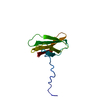 2h45C C: citing same article ( |
|---|---|
| Similar structure data | |
| Other databases |
|
- Links
Links
- Assembly
Assembly
| Deposited unit | 
| |||||||||
|---|---|---|---|---|---|---|---|---|---|---|
| 1 |
| |||||||||
| NMR ensembles |
|
- Components
Components
| #1: Protein | Mass: 22113.336 Da / Num. of mol.: 1 Fragment: Fibronectin first and second type III domain pair (1F3-2F3) Source method: isolated from a genetically manipulated source Source: (gene. exp.)  Homo sapiens (human) / Gene: FN1 / Plasmid: pGEX-6P-2 / Production host: Homo sapiens (human) / Gene: FN1 / Plasmid: pGEX-6P-2 / Production host:  |
|---|
-Experimental details
-Experiment
| Experiment | Method: SOLUTION NMR | ||||||||||||||||
|---|---|---|---|---|---|---|---|---|---|---|---|---|---|---|---|---|---|
| NMR experiment |
|
- Sample preparation
Sample preparation
| Details |
| ||||||||||||
|---|---|---|---|---|---|---|---|---|---|---|---|---|---|
| Sample conditions | Ionic strength: 150mM NaCl, 20mM Na2HPO3 / pH: 7 / Pressure: ambient / Temperature: 303 K |
-NMR measurement
| NMR spectrometer | Type: Home-built Home build / Manufacturer: Home-built / Model: Home build / Field strength: 750 MHz |
|---|
- Processing
Processing
| NMR software |
| ||||||||||||||||||||||||
|---|---|---|---|---|---|---|---|---|---|---|---|---|---|---|---|---|---|---|---|---|---|---|---|---|---|
| Refinement | Method: Rigid body docking with torsional flexibility at the interfacial amino acid sidechains Software ordinal: 1 Details: The structure was calculated by rigid body docking using ambiguous interdomain NOE-like restraints derived from chemical shift mapping of the interface and residual dipolar couplings of the ...Details: The structure was calculated by rigid body docking using ambiguous interdomain NOE-like restraints derived from chemical shift mapping of the interface and residual dipolar couplings of the complex. 7 residues from each domain were used for the ambiguous NOEs as well as 72 RDCs total. The refinement protocol was similar to that of Clore & Schwieters, JACS 125, 2902 | ||||||||||||||||||||||||
| NMR representative | Selection criteria: closest to the average | ||||||||||||||||||||||||
| NMR ensemble | Conformer selection criteria: Structures forming a single cluster after imposing a 50% lowest energy cutoff Conformers calculated total number: 100 / Conformers submitted total number: 39 |
 Movie
Movie Controller
Controller


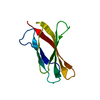

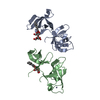

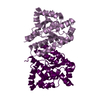
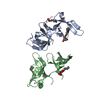




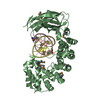
 PDBj
PDBj
















 HSQC
HSQC